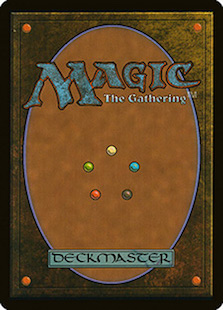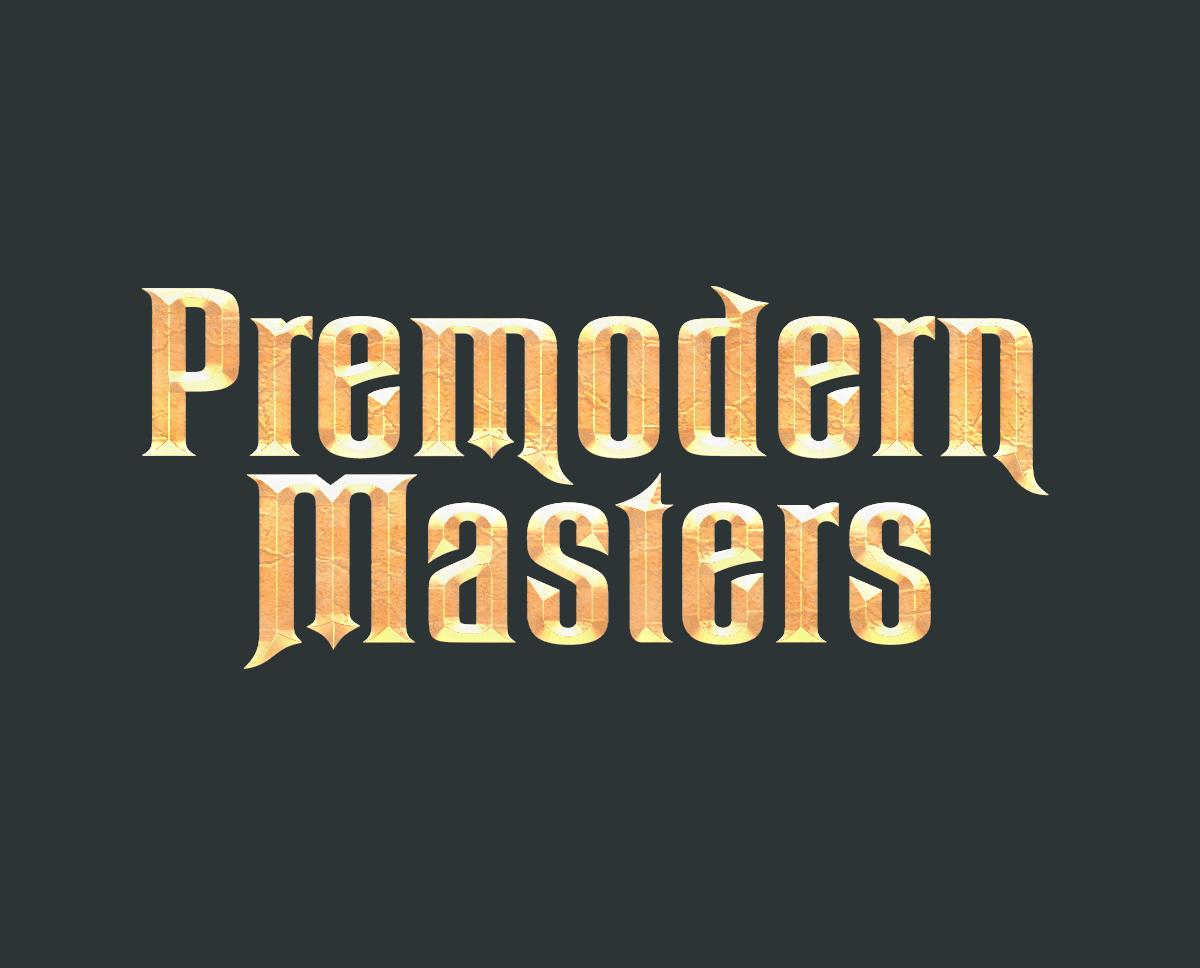The blog has been in quarantine, apparently, but now we’re back to present a very promising community project: Premodern Masters! In today’s article, the creators Max, Sakari, Kim and Aleksi from Finland introduce the project and describe the main deck archetypes of the set. Stay safe! / Martin
What is Premodern Masters?
Premodern Masters is a custom limited set designed by Max Sjöblom, Sakari Castrén, Kim Valori and Aleksi Väänänen. We wanted to create a drafting experience that combined the design ideas of modern Magic with the nostalgia of cards that are part of the Premodern card pool. The drafting experience is very close to sets like Vintage Masters or Modern Horizons, with the emphasis being on drafting archetypes, rather than just cards of two colours.
We spent a great deal of time designing this set, and we have prepared a series of articles which tell the story of this design process. This is the first article in the series, and focuses on mainly explaining what is in the set, how drafting works, and some basic strategies for each archetype. So this is perfect for you if you do not care that much about the nitty gritty of balancing, mana curve considerations and other minute details that have gone into the design. If you are interested in those aspects, stay tuned for the follow-up articles that are scheduled to be released in the coming weeks.
What is in the set?
The Premodern Masters set includes a total of 120 commons, 80 uncommons and 93 rares, so the rarity distribution is fairly close to modern Magic sets. In addition to these, the set also includes so called special lands, which there are 48 of. All the cards are part of the Premodern card pool, and with the exception of a few individual cards (Force of Will), all the cards in the set are also Premodern legal.
Many cards have had their original rarity shifted to make for a better overall experience. For example, Mistform Ultimus has been shifted from rare to common.
For a complete list of cards in a visual spoiler format, you can check out the website for the project: https://premodernmasters.com/
How does drafting work?
The physical draft box contains 4x of each common, 3x of each uncommon, 1x of each rare and 1x of each special land. When drafting, 15 card packs are made out of the contents of the draft box, so that each booster has 1 special land, 1 rare, 3 uncommons and 10 commons. That means that you can get multiples of the same common or uncommon throughout the draft, but not in the same booster.
Additionally, we have made a virtual setup using an MTGO account that includes all the requisite cards, and a separate online drafting client that takes the booster construction constraints of this set into consideration. The Premodern Masters webpage has a link to this draft service if you are interested in trying it yourself.
Draft archetypes
We created this short trailer as a fun way to introduce the archetypes in the set.
White and blue: Birds!
White and blue focuses on aggressive cheap flyers, with a particular focus on birds. You want to draft plenty of cheap one and two mana cards to get the most out of cards like Curiosity. This archetype has some very powerful uncommons available, which can lead you down this path early on in the draft.
Key commons: Suntail Hawk, Soulcatcher, Defiant Falcon, Curiosity, Rishadan Airship, Silver Drake
Key uncommons: Battle Screech, Soraya the Falconer, Keeper of the Nine Gales,
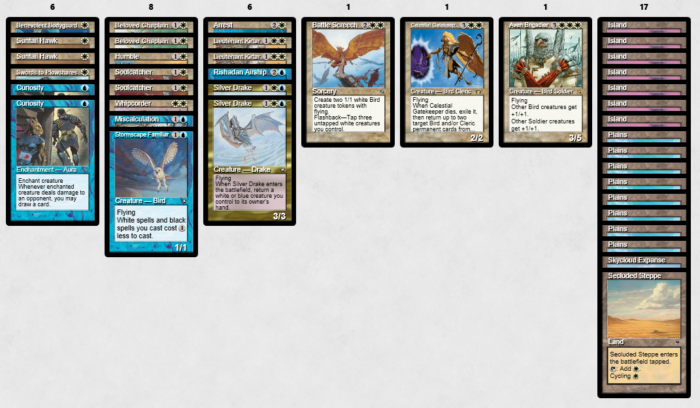
Note: Soraya the Falconer does not exist on Magic Online, so we use Aven Brigadier as a replacement.
White and black: Clerics
The clerics deck is a midrange deck that has plenty of staying power in the late game thanks to cards like Celestial Gatekeeper and Rotlung Reanimator at uncommon. This deck often stabilizes the board, and then finishes with an individual strong threat, or a more grindy win condition like Cabal Archon. There is also a minor recursion subtheme involving Monk Idealist combined with the black removal spells Sicken, Exotic Curse and Seal of Doom.
Key commons: Battlefield Medic, Monk Idealist, Cabal Archon, Seal of Doom, Unearth
Key uncommons: Rotlung Reanimator, Master Apothecary, Celestial Gatekeeper, Phyrexian Reclamation
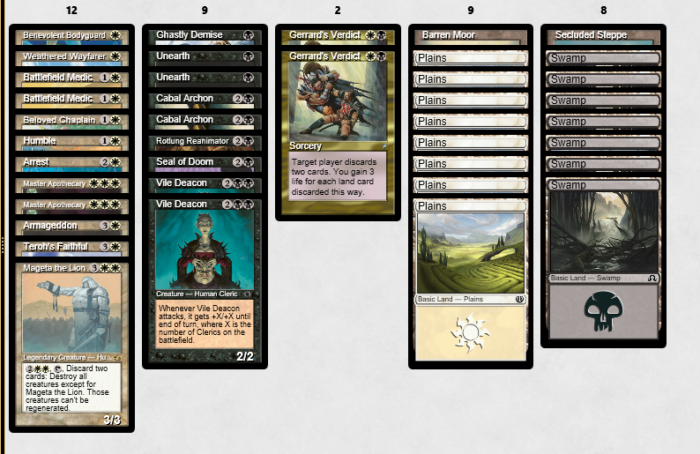
White and red: Cycling Control
This archetype is one of the two primary control archetypes (alongside blue and red). A lot of weight is placed on the cycling mechanic, and if you don’t get at least one of the payoff uncommons, your deck may end up very lacklustre. This is one of those archetypes you easily end up in if you open up a Lightning Rift or Astral Slide in your first booster, but switching to this late in pack two is quite difficult.
Cards with cycling should be picked very highly once you have cemented your position in this archetype. The cycling lands especially are important to have enough fuel for your payoff cards.
Key commons: Chartooth Cougar, Solar Blast, Spark Spray, Stoic Champion, Teroh’s Faithful
Key uncommons: Astral Slide, Lightning Rift, Spirit Cairn, Soltari Guerrillas

White and green: Enchantress
This deck is a take on the classic Enchantress archetype which is mainly familiar from constructed. An aggressive deck by nature, which can obtain some card advantage from cards like Argothian Enchantress. The individual auras are strong, but you are setting yourself up for getting blown out by removal spells, so striking a balance is important here. Prioritise cheap creatures so that you have something to put all those auras on. There are some fun combos available, such as combining Auratog with either Rancor or Brilliant Halo to attack for a lot of damage.
Key commons: Arrest, Phantom Nomad, Ancestral Mask, Fertile Ground, Yavimaya Enchantress, Armadillo Cloak
Key uncommons: Argothian Enchantress, Elephant Guidee, Rancor, Serra’s Embrace

Blue and black: Zombie Graveyard
This is a bit of a weird archetype, and not something seen in pretty much any limited format. When this deck comes together well it resembles Dredge, but with a bit more play for the opponent. The idea here is to abuse creatures that recur from the graveyard, such as Ichorid and Ashen Ghoul at common, and Krovikan Horror at uncommon. Zombie Infestation lets you discard these monsters, and there is also a bit of zombie tribal action going on with Undead Warchief.
When you get a really good version of this deck, it’s a beauty to behold. However, it is also probably the hardest archetype in this format to draft correctly, since you need to strike a balance between all the various parts needed.
Key commons: Ichorid, Ashen Ghoul, Zombie Infestation, Merfolk Looter, Tolarian Winds, Deep Analysis, Probe
Key uncommons: Krovikan Horror, Squee, Goblin Nabob, Wonder, Psychatog
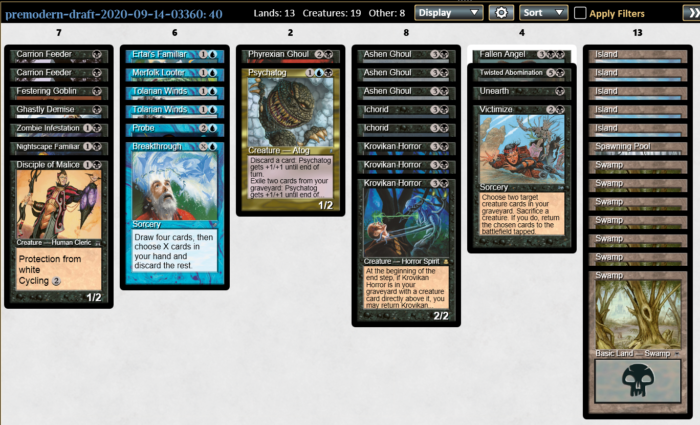
Blue and red: Stacking Spells
This archetype leans heavily towards the controlling role. The name refers to cards that get better in multiples, such as Accumulated Knowledge, Kindle and Flame Burst. This deck is all about using cheap answers to survive into the late game where you can leverage your card advantage and end the game with a couple of individual threats.
Key commons: Accumulated Knowledge, Deep Analysis, Scrivener, Flame Burst, Kindle, Heat Ray, Solar Blast, Jilt
Key uncommons: Fact or Fiction, Counterspell, Intuition, Volcanic Dragon, Suffocating Blast, Sapphire Medallion
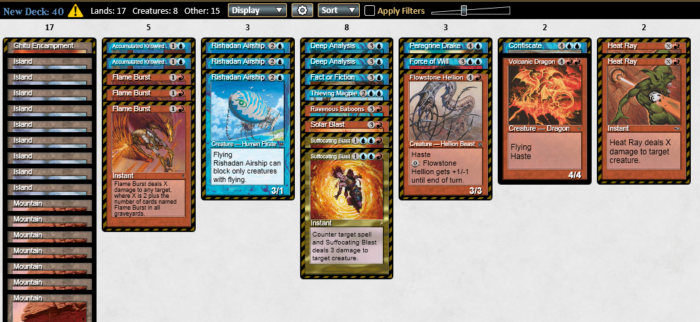
Note: this particular deck had some cheaper creatures in Rishadan Airship, something which is not so usual in these decks. Unfortunately we could not find another saved picture of an example deck for blue and red.
Blue and green: Threshold
This is a block constructed favorite from Odyssey, where counting to 7 is all that matters (kinda). Using cheap and effective enablers lets you get undercosted threats such as Nimble Mongoose and Werebear online early. Fetches and cycling lands become high picks as they let you fill your graveyard for almost no cost. Wood Sage is one of the very best cards for this archetype, since it lets you easily get threshold on turn four.
This can be a tricky deck to draft, as you need to balance your enablers with your payoffs, or else you will end up with a very mediocre deck. However, when things work out and you cast a Grizzly Fate for four bears on turn five, it’s very difficult to lose.
Key commons: Nimble Mongoose, Werebear, Seton’s Scout, Mental Note, Merfolk Looter, Tolarian Winds
Key uncommons: Wood Sage, Grizzly Fate, Roar of the Wurm, Wonder, Waterfront Bouncer, Ertai’s Familiar
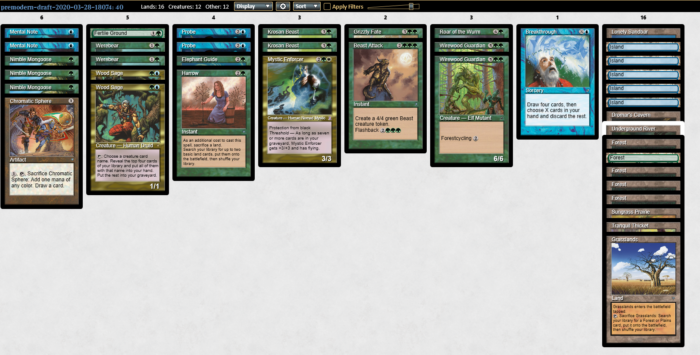
Black and red: Goblins
Goblins is the most aggressive deck available in this format. This deck often ends up being almost mono red, with a few black cards mixed in. Priority should be given to cards that give you the best possible curve, and creatures are much more important than mediocre removal spells such as Kindle in this deck.
See also the note in “other archetypes” regarding drafting red aggressive decks.
Key commons: Goblin Patrol, Goblin Sledder, Goblin Ringleader, Mogg Flunkies, Cabal Slaver
Key uncommons: Sparksmith, Gempalm Incinerator, Goblin Warchief, Dralnu’s Crusade,
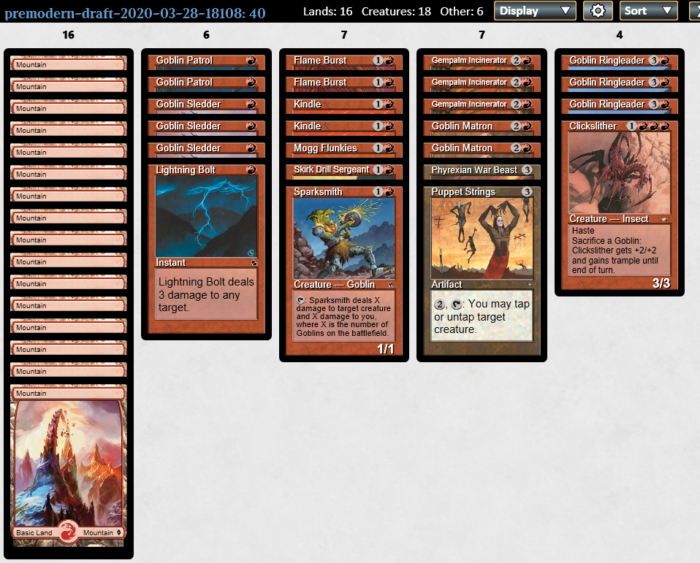
Note: this deck had some black cards in the sideboard, but ended up playing most games as just a mono red deck for the sake of consistency.
Black and green: Sacrifice Value
This deck tries to grind the opponent out of resources, while simultaneously offering some very explosive finishes by sacrificing creatures to Phyrexian Ghoul. When you get the right cards, this deck can sometimes resemble a combo deck, where you deal 20 damage in one turn with a single Phyrexian Ghoul attack.
A fun interaction is that you have to manage when you sacrifice your Mongrel Pack, since if it dies outside of the combat phase, you don’t get any tokens. This can be relevant when you think your opponent has something like Kindle to kill the Mongrel Pack on their own turn.
Key commons: Phyrexian Ghoul, Carrion Feeder, Phyrexian Rager, Wirewood Herald, Symbiotic Beast, Sylvan Might.
Key uncommons: Fallen Angel, Hell’s Caretaker, Mongrel Pack, Caller of the Claw
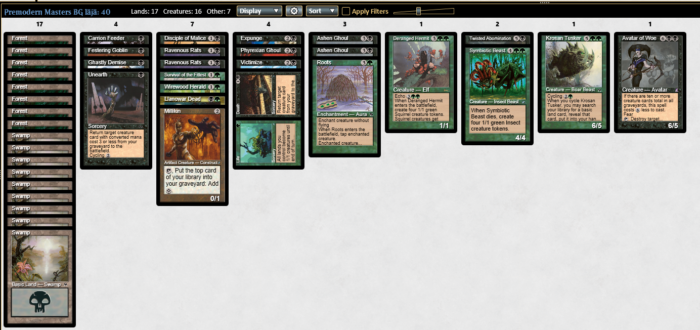
Red and green: Beasts
Red green beasts is a straightforward midrange creature deck that should take any mana acceleration it sees very highly, as the beasts themselves are fairly expensive. If you manage to pick up a few Fyndhorn Elves and follow those up with a Krosan Warchief, suddenly you are casting expensive beasts very early on in the game.
It is also worth remembering that Phyrexian War Beast is an actual beast, so you can use it to feed the amplify mechanic on Canopy Crawler, and draw a card from Wirewood Savage.
Key commons: Fyndhorn Elves, Krosan Warchief, Canopy Crawler, Wirewood Savage, Chartooth Cougar, Flowstone Hellion
Key uncommons: Fires of Yavimaya, Blastoderm, Beast Attack, Ravenous Baloth, Ancient Hydra, Contested Cliffs
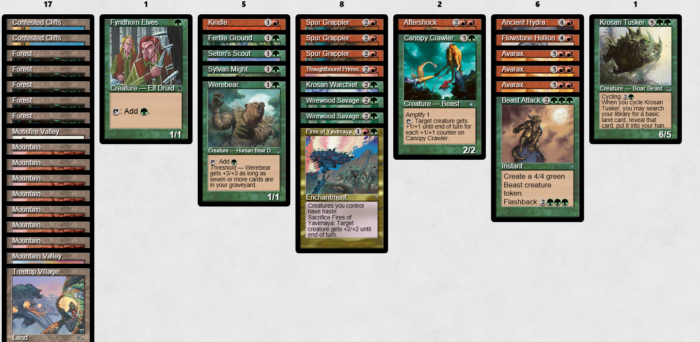
Other archetypes
You might not always end up exactly where you wanted to go, and sometimes you need to improvise. To help with this, there are also a number of other archetypes that sometimes pop up in Premodern Masters drafts. Some of these have been included by design, but some have appeared more organically.
Here are a few of them briefly.
Multicolor control (URx)
This deck takes the basic UR control archetype and adds black for additional removal and Probe, or alternatively adds white for some individually powerful cards like Goblin Trenches or Soltari Guerrillas. Splashing is made easier by the mana fixing lands available throughout the boosters.

Red aggro
Goblins is not always red and black, as sometimes you might want to combine the basic red shell of Goblins with white cards like Goblin Legionnaire and Arrest, or perhaps blue cards like Memory Lapse and Jilt. Since the deck often plays 18+ red cards, you gain a lot of flexibility by adding 3–4 cards from basically any other colour (green is not that popular here).
Red aggro decks don’t always need to be Goblins focused, as sometimes just combining your local Goblins, Slivers and other assorted cheap creatures can mean you are smashing your opponent before they have time to properly react.
Slivers
We have intentionally included Slivers as another aggro deck. This deck is most commonly green and red, but sometimes you might see a red and black deck with just a small number of slivers. While individual slivers such as Muscle Sliver and Blade Sliver are not great on their own, once you get 7+ of any combination of these, they get a lot better. Playing Muscle Sliver on turn two, followed by another on turn three, and then a Spined Sliver on turn four really puts your opponent against the ropes.
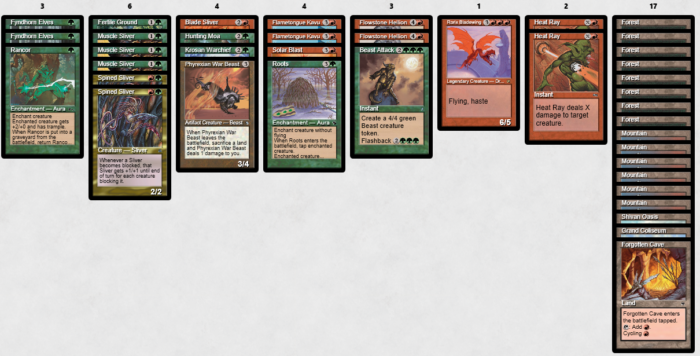
Domain
Five color green is a deck that was popular in Invasion limited (and also in several modern limited formats). Green offers a lot of fixing at common, with Fertile Ground, Harrow and Krosan Tusker helping to improve your mana. While there are not that many direct domain payoffs at common and uncommon aside from Exotic Curse and Ordered Migration, playing multiple colours easily lets you splash powerful cards you might get later in the draft. Cards like Rith, the Awakener might not easily slot into many decks, and hence you might get it late in the third booster.
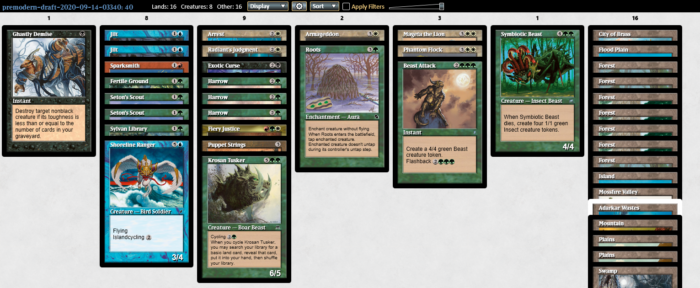
Sounds great, where can I play it?
If you are interested in trying out the format yourself, be sure to check out the full card list on the Premodern Masters website. From there, you can find a link to the online draft service we have put together, where you can play draft and build sealed pools together with other human players. You can then play the matches in your Magic simulator of choice, or Magic Online if you have all the cards. If you have questions about the set or getting a draft going, feel free to reach out to Max on Twitter.
Stay tuned for two more articles coming out in the following weeks. These will go into more detail regarding the design process of the set, as well as how we put together the finished physical product alongside the digital platform.
Until next time!
– Max, Sakari, Kim and Aleksi
